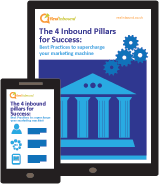HubSpot, simplifies the A/B testing of your inbound marketing, thus delivering better results & providing optimum experience with each new venture.
Digital marketing is an ever-evolving field and having the right strategy can make a massive difference in the success of any business. Two key factors that drive digital marketing success are increasing website traffic and increasing conversions. Both of these goals require different strategies and tactics, but they are both essential for achieving long-term success. With the right combination of tools, techniques, and knowledge, businesses can maximise their reach and convert more visitors into actual customers.
Having said that, Accomplishing something like increasing your conversion rate requires both effort and financial investment - it is by no means an easy feat. It takes substantial time and resources to make any significant improvements. Implementing inbound marketing can require up to 100 hours a month of investment to start seeing results. This time is necessary if you want to generate momentum and improve your business processes.
Juggling all your essential tasks each month can feel overwhelming, and you might be wondering if spending time on testing & optimising your marketing is worth it. The fact is, making improvements to your campaigns can have major impacts on results.
HubSpot A/B testing guide
If you're looking at A/B testing your inbound marketing campaigns on HubSpot, you should start by determining what specifically needs to be tested. This could be anything from the messaging on your landing pages, the design of your emails, or the calls to action on your website. It's important to think about what you're trying to learn from the test, as this will help you determine which elements of your inbound marketing strategy you should be testing.
- Don't overtest, or your results will be muddled
A/B testing is an important part of marketing, and you may be getting excited about experimenting with all your ideas. However, it's essential to not let enthusiasm overpower your practical approach and take things too far. Doing too many tests simultaneously on interlinked elements can get overwhelming and you may become disoriented. It's best to limit the number of tests so that it's easier to keep track of everything.
Interlinking elements refer to the process of connecting a CTA (call to action button) with a landing page. As an example, when someone clicks on the CTA, it directs them to the designated landing page. It's highly advisable not to test the wording of your Call To Action (CTA) and the headline on the same landing page, simultaneously. Trying to adjust multiple elements would make it difficult to identify which factor was responsible for any improvement in conversions.
- Think bigger if you want to stand out
Don't just limit yourself to testing small elements like button colour or background shade. You should also try out other variables such as making the entire landing page, call-to-action or email a test subject in itself.
Marketers looking for prompt results, especially those intending to change their homepage design, can find great advantages in this approach. Having the control version allows you to revert to it if changes prove inadvisable. However, it's important to take some time and figure out what exactly caused the change. This is one of the few drawbacks of this approach.
- Testing minor changes are important
While trying out new big changes can be beneficial, don't forget to pay attention to the little details. Even something as small as replacing an image on your homepage or altering the colour of a CTA button can lead to significant improvements. In reality, the smaller modifications are usually easier to monitor compared to the larger ones.
- Count as far down as you can on the funnel
A/B testing can be a really useful tool for gauging the success of different marketing tactics. It can help you increase website traffic and conversions, making it an invaluable resource for businesses. However, it's important to consider how these changes might affect your overall sales figures as well. With careful analysis of the data collected from A/B tests, businesses can make informed decisions that are beneficial for their bottom line.
An email with fewer links or a landing page with fewer conversions may still generate more sales in the long run. Your main goal is to convert leads into customers, so you must keep an eye out and make sure your content quality isn't compromised by increased quantity.
CHECK OUT THIS ARTICLE: 10 Fantastically Easy A/B Testing Best Practices
- Have a test control in place
It's essential to maintain the original version of the object you're experimenting with, which serves as the 'control' in your experiment. This ensures that there are no changes made to it before comparing it with other results. Subsequently, create a different version and compare it to the regular one. An instance of this could be if you already have a red button on your CTA.
To put it simply, A/B testing is a must-have tool for businesses that want to gain an edge in the online space. It can uncover the most efficient conversion tactics and ultimately result in improved performance. By creating two versions of a webpage, one with a red button and one with a green button, we can see if the colour of the button has an impact on click-throughs. This will help us understand if introducing the green button can potentially boost our conversions and unlock further opportunities for improvement.
- Test your hypothesis
Understandably, you may not want to test all of the components such as call-to-actions, website forms, landing pages, and emails right away. There are plenty of other testing options available for you to explore and implement when ready.
- Make random splits in your sample group
For reliable and accurate results, it is essential to test two or more groups of equal sizes. With the help of HubSpot, you can easily split the visitors between the two landing pages/Calls-To-Action (CTAs) for A/B testing. While sending emails, you can determine the number of people you wish to test it on before finalising & sending the successful version to the remaining recipients. To make the most of split testing, an ideal ratio should be 15% for version A, 15% for version B and the winning version taking up 70%. However, if your list size is less than 1,000 then the split should be 50/50.
- Decide whether your results are significant
When assessing the outcomes of a test, it is essential to make sure that any disparity in conversion rate between the variation & control isn't just based on luck and that it has solid statistical significance. Doing so will enable you to draw rational decisions and practical insight from it.
It's important to consider the size of your target audience when making any business decisions, as this will determine the amount of risk you are willing to take. Doing so can help ensure that you make the best decisions possible. When your target audience is limited in size, you run a greater risk of facing statistical significance issues. To reduce this risk, it's important to be cautious about what your point of statistical significance should be since you'll have fewer data points to work with.
So there you have it
Data and testing are essential to achieving your goals. Investing the necessary effort in thoroughly examining data and testing can dramatically improve the success rate of your final output. By examining the data, you can gain valuable insights into what works and what doesn’t, allowing you to adjust your strategy accordingly. Additionally, testing before launch can help you avoid any unforeseen issues that could arise when trying to reach your goal. Investing time in researching, analysing, and testing is a surefire way to maximise your chances of success.
The key to successful experimentation lies in taking things one step at a time and prioritising tests based on their potential impact. This requires patience and discipline, but it ensures that we're always making progress toward our goals. By experimenting with new ideas and methods, we can identify what works best for our business and make the necessary modifications to get the best possible results. Remember that you can always change things back again once the test is over, so don't be afraid of trying something out — it's worth it in the long run!





